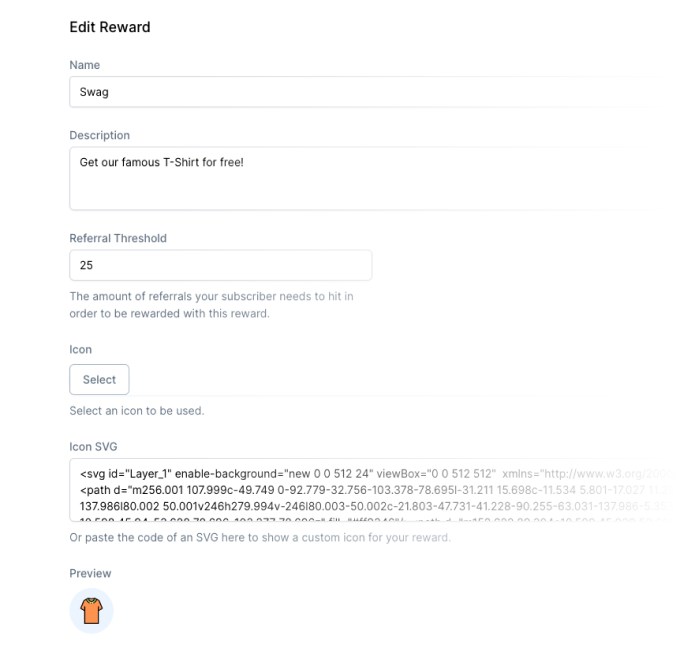7 Proven Reward Strategies for Newsletter Referral Programs
How to Choose Incentives That Actually Drive Growth

When building a newsletter referral program, one question towers above all others: “What rewards should I offer?” This seemingly simple question can make or break your entire referral strategy.
After analyzing hundreds of successful newsletter referral programs and helping publishers implement their own with Firewards, we’ve identified the reward strategies that consistently deliver results. In this post, we’ll explore seven proven approaches to designing newsletter referral rewards that drive meaningful growth.
Why Your Reward Strategy Matters More Than You Think
Before diving into specific reward types, let’s clarify why this decision is so critical. Your rewards aren’t just prizes—they’re powerful psychological triggers that must accomplish several objectives simultaneously:
- Motivate initial sharing behavior
- Drive continued participation over time
- Align with your newsletter’s value proposition
- Remain financially sustainable as you scale
- Appeal specifically to your audience demographic
The most successful newsletter referral programs strike a delicate balance between these factors. Morning Brew didn’t become a referral success story by accident—they meticulously designed a reward system that aligned perfectly with their audience’s interests and their business model.
Strategy #1: The Exclusive Content Approach
Best for: Information-focused newsletters, industry publications, analysis-heavy content
Example: Morning Brew’s Sunday newsletter exclusive for 3+ referrals
The exclusive content approach leverages your core strength as a newsletter publisher—your ability to create valuable information. By offering additional content as a reward, you:
- Maintain zero marginal cost per reward
- Reinforce your value proposition
- Appeal directly to subscribers who already value your content
- Create a clear path to upgrade through referrals
A tech newsletter might offer an exclusive “early trends” report each month to subscribers who refer three friends. A finance newsletter could provide special stock analysis to active referrers. The key is making this content genuinely valuable and unavailable through other channels.
Implementation tip: When creating exclusive content rewards, maintain the same quality standard as your main newsletter. Treating this as a throwaway will undermine your entire referral program.
Strategy #2: The Digital Asset Ladder
Best for: Multi-topic newsletters, creators with expertise to share, educational content
Example: Milk Road’s cryptocurrency guides for referrers
Digital assets—ebooks, templates, guides, downloads—make excellent referral rewards because they:
- Scale infinitely with near-zero marginal cost
- Provide immediate delivery (no fulfillment delays)
- Allow for multiple reward tiers without significant additional work
- Can be highly specific to your audience’s interests
A productivity newsletter might offer a template collection for 1 referral, a complete workflow system for 5 referrals, and a comprehensive productivity course for 10 referrals. This creates a natural progression that encourages ongoing participation.

Implementation tip: Create your highest-tier digital reward first, then extract portions or simplified versions for lower referral milestones. This approach ensures coherence across your reward tiers.
Strategy #3: The Community Access Model
Best for: Newsletters with engaged audiences, topic areas where peer connection adds value
Example: The Hustle’s private community for referrers
Community-based rewards leverage the network effect of your subscriber base by:
- Creating additional value through peer connections
- Fostering deeper engagement with your brand
- Providing a sense of exclusivity and belonging
- Creating a space where your most engaged readers connect
This approach works particularly well for newsletters covering topics where community discussions add substantial value—finance, technology, professional development, or specialized hobbies.
Implementation tip: Start your community with clear guidelines and active moderation. The early culture you establish will determine whether this becomes a valuable reward or a management headache.
Strategy #4: The Recognition Hierarchy
Best for: Newsletters with status-conscious audiences, professional topics, industry publications
Example: TheSkimm’s ambassador program with public recognition
Some audiences are highly motivated by public recognition. This approach works by:
- Showcasing top referrers in your newsletter
- Creating leaderboards for friendly competition
- Offering “ambassador” status for active referrers
- Providing special badges or identifiers in community settings
This strategy costs virtually nothing to implement but can drive significant referral activity for the right audience. It works best when your subscribers view association with your brand as status-enhancing within their professional or social circles.
Implementation tip: Make recognition visible both publicly and within your newsletter community. The dual validation maximizes the psychological reward.
Strategy #5: The Branded Merchandise Path
Best for: Newsletters with strong brand identity, lifestyle content, personality-driven publications
Example: Morning Brew’s progressive merchandise rewards (stickers → mugs → apparel)
The merchandise approach is the most common strategy, but its effectiveness varies dramatically based on execution:
- Strong brand affinity is essential—subscribers must want to identify with your brand
- Quality matters more than quantity—cheap merchandise undermines perceived value
- Progressive value tiers create a clear reward journey
- Fulfillment logistics must be streamlined to avoid becoming overwhelming
This approach works best when wearing or displaying your brand has social currency within your audience’s circles. Morning Brew succeeded because their audience of young business professionals viewed the brand as aspirational.
Implementation tip: Start with low-cost, high-margin items for initial tiers (stickers, digital downloads) before offering higher-value merchandise requiring fulfillment.
Strategy #6: The Experience-Based Incentive
Best for: Premium newsletters, B2B publications, high-value content areas
Example: Industry newsletters offering private events or calls with experts
Experience-based rewards offer exclusive access to events or interactions:
- Virtual coffee with the newsletter author
- Private Q&A sessions with industry experts
- Exclusive webinars or workshops
- Access to in-person events
These rewards create memorable experiences that strengthen subscriber loyalty while providing clear value differentiation between referral tiers. They’re particularly effective for newsletters covering professional topics where expertise access has tangible value.
Implementation tip: Calendar these experiences at regular intervals rather than trying to schedule them ad hoc as people reach milestones. This approach is more sustainable as your program scales.
Strategy #7: The Platform Extension Strategy
Best for: Newsletters associated with software products, paid services, or premium content
Example: Product-focused newsletters offering extended free trials or premium features
If your newsletter connects to a broader platform or paid service, your referral rewards can introduce subscribers to your premium offerings:
- Extended free trials of paid features
- Credit toward premium subscriptions
- Early access to new features or content
- Temporary access to paid tiers
This approach not only incentivizes referrals but serves as a marketing channel for your broader business, allowing subscribers to experience premium features that they might later pay for.
Implementation tip: Ensure the premium features you offer as rewards showcase clear value that differentiates from your free offerings. This exposure should drive both referrals and potential conversions.
Designing Your Multi-Tiered Reward System
The most successful newsletter referral programs don’t rely on a single reward strategy—they combine multiple approaches into a cohesive system. Here’s a framework for structuring your rewards:
Entry Level (1-3 Referrals)
Focus on instant gratification and achievable goals to build momentum:
- Exclusive content additions
- Digital downloads
- Community access
- Digital badges or recognition
Mid-Level (4-10 Referrals)
Increase value while maintaining reasonable fulfillment costs:
- Premium digital resources
- Lower-cost physical merchandise
- Special access or features
- Mid-tier recognition
Premium Level (10+ Referrals)
Reward your super-advocates with truly special incentives:
- High-value physical products
- One-on-one experiences
- Top-tier recognition
- Comprehensive resource collections

The magic happens when you create a natural progression that keeps subscribers motivated throughout their referral journey. Each milestone should feel attainable from the previous one, creating a clear path forward.
Implementation Best Practices
Beyond choosing the right rewards, implementation details significantly impact success:
1. Visual Progress Tracking
Make progress toward the next reward visible and engaging:
- Show current referral count in every newsletter
- Visualize progress toward next milestone
- Celebrate achievements to reinforce behavior
2. Clear Reward Communication
Subscribers should instantly understand what they’re working toward:
- Showcase rewards visually when possible
- Describe exclusive content benefits specifically
- Set clear expectations for fulfillment timeframes
3. Reward Fulfillment Automation
Manual fulfillment quickly becomes unsustainable:
- Automate digital reward delivery
- Use integration tools for physical fulfillment
- Create systems for experience-based rewards
With Firewards, these processes are handled automatically, allowing you to focus on creating valuable rewards rather than managing the logistics.
Measuring Reward Effectiveness
How do you know if your rewards are working? Track these key metrics:
- Activation Rate: Percentage of subscribers who make at least one referral
- Milestone Achievement: Distribution of subscribers across referral milestones
- Abandonment Points: Where subscribers stop making referrals
- Reward Fulfillment Cost: Total cost divided by new subscribers acquired
These metrics help you identify which rewards are driving behavior and which might need refinement.
Conclusion: Your Reward Strategy Is Your Growth Strategy
Your newsletter referral rewards aren’t just incentives—they’re the engine that powers your word-of-mouth growth. When designed thoughtfully, they create a virtuous cycle where each new subscriber becomes a potential ambassador for your newsletter.
The most successful newsletters—from Morning Brew to The Hustle to The Skimm—understand that their reward strategy is inseparable from their growth strategy. By applying the principles outlined in this post, you can create a referral reward system that not only motivates sharing but reinforces the unique value of your newsletter.
Ready to implement these reward strategies in your newsletter? Get started with Firewards today and transform your subscribers into your most powerful growth channel.
Published by

Rosalee Melvin